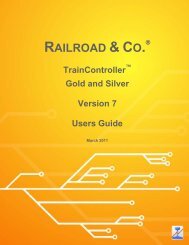Download - Freiwald Software
Download - Freiwald Software
Download - Freiwald Software
You also want an ePaper? Increase the reach of your titles
YUMPU automatically turns print PDFs into web optimized ePapers that Google loves.
this engine tends to exceed pre-set braking ramps or stop distances when it is slowed<br />
down, then increase this value. The default value is 0, which means, that no compensation<br />
is performed. Please note: this option has only an effect in conjunction with combined<br />
brake/stop indicators or Virtual Contacts and only when engines are decelerated<br />
before reaching their location.<br />
Measuring the speed profile is especially important for all engines, which will run under<br />
control of the Dispatcher (see chapter 5, “The Visual Dispatcher”). The Dispatcher<br />
uses the scale speed to control the engines. In this way engines with different characteristics<br />
pass the same track sections with identical speed, if the speed profile of each engine<br />
is adjusted accordingly.<br />
3.6 Headlights, Steam and Whistle<br />
For each engine an arbitrary number of engine function controls (e.g. light, sound,<br />
smoke, etc.) can be defined. Each function can perform one of the following:<br />
• activating a built-in function of an engine decoder<br />
• executing a macro (see section 12.6, “Macros”)<br />
• playing a sound file<br />
Engine Functions are executed<br />
• manually by using the auxiliary function controls of the train window<br />
• by macros (see section 12.6, “Macros”)<br />
• when a schedule is executed (see section 5.10, “Schedules”)<br />
If engine functions are executed by macros or schedules, then the particular function is<br />
identified by its name and symbol (e.g. Light, Smoke, etc.). If for a example a certain<br />
schedule has to perform the function symbol Whistle, then the function is executed,<br />
which is assigned to the engine as Whistle. If no such function symbol is assigned, then<br />
nothing happens.<br />
You can specify an individual tip for each function. This is arbitrary text which is displayed<br />
in a small popup window, when the mouse is moved over a function button in<br />
the Train Window. This tip text helps to distinguish between different functions that are<br />
associated with similar function symbols (such as Light 2, Light 3 , …).<br />
The actually executed function may be different from engine to engine. This is illustrated<br />
by the following example. It is assumed, that a built-in sound function of the cor-<br />
81










